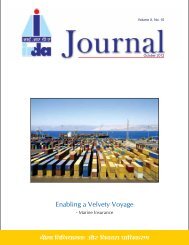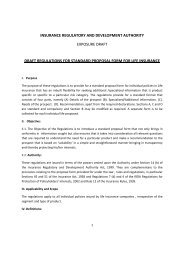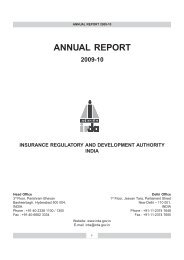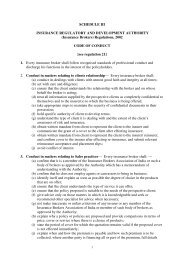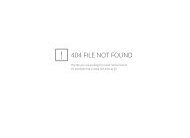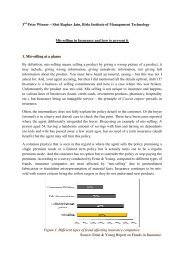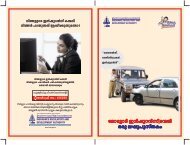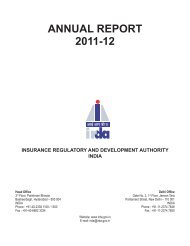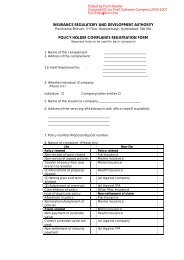Life Insurance Handbook (PDF) - MetLife
Life Insurance Handbook (PDF) - MetLife
Life Insurance Handbook (PDF) - MetLife
You also want an ePaper? Increase the reach of your titles
YUMPU automatically turns print PDFs into web optimized ePapers that Google loves.
Is your insurance company<br />
listening to you?<br />
If your complaints have not been addressed<br />
by your insurance company,<br />
please contact<br />
to register your complaints and track their status<br />
or you may email us at complaints@irda.gov.in<br />
<strong>Handbook</strong> on<br />
<strong>Life</strong> <strong>Insurance</strong>
1. About this handbook<br />
Contents:<br />
1. About this handbook 1<br />
2. <strong>Life</strong> <strong>Insurance</strong> 2<br />
3. Frequently asked questions 8<br />
4. Policyholder Servicing TATs 18<br />
5. If you have a grievance 19<br />
This handbook is designed by the <strong>Insurance</strong> Regulatory<br />
and Development Authority (IRDA) as a guide on<br />
<strong>Life</strong> <strong>Insurance</strong> and gives general information only. No<br />
information given herein replaces or overrides the terms<br />
and conditions of an insurance policy.<br />
Please approach a duly licensed agent or a broker or an<br />
insurance company registered with IRDA for specific<br />
information regarding a policy or for any other<br />
additional information.<br />
<strong>Insurance</strong> is the subject matter of solicitation<br />
1
2<br />
2. <strong>Life</strong> <strong>Insurance</strong><br />
• <strong>Life</strong> <strong>Insurance</strong> is a financial cover for a contingency<br />
linked with human life, like death, disability,<br />
accident, retirement etc. Human life is subject to<br />
risks of death and disability due to natural and<br />
accidental causes. When human life is lost or a<br />
person is disabled permanently or temporarily, there<br />
is loss of income to the household.<br />
• Though human life cannot be valued, a monetary<br />
sum could be determined based on the loss of<br />
income in future years. Hence, in life insurance, the<br />
Sum Assured ( or the amount guaranteed to be paid<br />
in the event of a loss) is by way of a ‘benefit’. <strong>Life</strong><br />
<strong>Insurance</strong> products provide a definite amount of<br />
money in case the life insured dies during the term of<br />
the policy or becomes disabled on account of an<br />
accident.<br />
• Why you should buy <strong>Life</strong> <strong>Insurance</strong>:<br />
All of us face the following risks:<br />
Dying too soon<br />
Living too long<br />
<strong>Life</strong> <strong>Insurance</strong> is needed :<br />
To ensure that your immediate family has some<br />
financial support in the event of your demise<br />
To finance your children’s education and other<br />
needs<br />
To have a savings plan for the future so that you<br />
have a constant source of income after retirement<br />
To ensure that you have extra income when your<br />
earnings are reduced due to serious illness or<br />
accident<br />
To provide for other financial contingencies and life<br />
style requirements<br />
• Who needs <strong>Life</strong> <strong>Insurance</strong>:<br />
Primarily, anyone who has a family to support and is<br />
an income earner needs <strong>Life</strong> <strong>Insurance</strong>. In view of<br />
the economic value of their contribution to the<br />
family, housewives too need life insurance cover.<br />
Even children can be considered for life insurance in<br />
view of their future income potential being at risk.<br />
• How much <strong>Life</strong> <strong>Insurance</strong> is needed:<br />
The amount of <strong>Life</strong> <strong>Insurance</strong> coverage you need<br />
will depend on many factors such as:<br />
How many dependants you have<br />
Whether you have any debts or mortgages<br />
What kind of lifestyle you want to provide for your<br />
family<br />
How much you need for your children’s education<br />
What your investment needs are<br />
What your affordability is<br />
You should seek the help of an insurance agent or<br />
broker to understand your insurance needs and<br />
suggest the right type of cover.<br />
3
4<br />
• Kinds of <strong>Life</strong> <strong>Insurance</strong> Policies:<br />
Term <strong>Insurance</strong><br />
You can choose to have protection for a set period of<br />
time with Term <strong>Insurance</strong>. In the event of death or<br />
Total and Permanent Disability if the benefit is<br />
offered), your dependants will be paid a benefit. In<br />
Term <strong>Insurance</strong>, no benefit is normally payable if the<br />
life assured survives the term.<br />
Whole <strong>Life</strong> <strong>Insurance</strong><br />
With whole life insurance, you are guaranteed<br />
lifelong protection. Whole life insurance pays out a<br />
death benefit so you can be assured that your family<br />
is protected against financial loss that can happen<br />
after your death. It is also an ideal way of creating an<br />
estate for your heirs as an inheritance.<br />
Endowment Policy<br />
An Endowment Policy is a savings linked insurance<br />
policy with a specific maturity date. Should an<br />
unfortunate event by way of death or disability occur<br />
to you during the period, the Sum Assured will be<br />
paid to your beneficiaries. On your surviving the<br />
term, the maturity proceeds on the policy become<br />
payable.<br />
Money back plans or cash back plans:<br />
Under this plan, certain percent of the sum assured is<br />
returned to the insured person periodically as<br />
survival benefit. On the expiry of the term, the<br />
balance amount is paid as maturity value. The life<br />
risk may be covered for the full sum assured during<br />
the term of the policy irrespective of the survival<br />
benefits paid.<br />
Children Policies<br />
These types of policies are taken on the life of the<br />
parent/children for the benefit of the child. By such<br />
policy the parent can plan to get funds when the<br />
child attains various stages in life. Some insurers<br />
offer waiver of premiums in case of unfortunate<br />
death of the parent/proposer during the term of the<br />
policy.<br />
Annuity (Pension) Plans<br />
When an employee retires he no longer gets his<br />
salary while his need for a regular income continues.<br />
Retirement benefits like Provident Fund and<br />
gratuity are paid in lump sum which are often spent<br />
too quickly or not invested prudently with the result<br />
that the employee finds himself without regular<br />
income in his post - retirement days. Pension is<br />
therefore an ideal method of retirement provision<br />
because the benefit is in the form of regular income.<br />
It is wise to provide for old age, when we have<br />
regular income during our earning period to take<br />
care of rainy days. Financial independence during<br />
old age is a must for everybody.<br />
5
There are two types of annuities (pension plans).<br />
• Immediate Annuity<br />
In case of immediate Annuity, the Annuity payment<br />
from the <strong>Insurance</strong> Company starts immediately.<br />
Purchase price (premium) for immediate Annuity is<br />
to be paid in Iumpsum in one installment only.<br />
• Deferred Annuity<br />
Under deferred Annuity policy, the person pays<br />
regular contributions to the <strong>Insurance</strong> Company, till<br />
the vesting age/vesting date. He has the option to<br />
pay as single premium also. The fund will<br />
accumulate with interest and fund will be available<br />
on the vesting date. The insurance company will<br />
take care of the investment of funds and the<br />
policyholder has the option to encash 1/3rd of this<br />
corpus fund on the vesting age / vesting date tax<br />
free. The balance amount of 2/3rd of the fund will be<br />
utilized for purchase of Annuity (pension) to the<br />
Annuitant.<br />
Unit Linked <strong>Insurance</strong> Policy<br />
Unit Linked <strong>Insurance</strong> Policies (ULIPs) offer a<br />
combination of investment and protection and<br />
allow you the flexibility and choice on how your<br />
premiums are invested. IN UNIT LINKED PLANS,<br />
THE INVESTMENT RISK PORTFOLIO IS<br />
BORNE BY YOU AS YOU ARE THE INVESTOR<br />
Typically, the policy will provide you with a choice of<br />
funds in which you may invest. You also have the<br />
flexibility to switch between different funds during<br />
the life of the policy. The value of a ULIP is linked to<br />
the prevailing value of units you have invested in<br />
the fund, which in turn depends on the fund’s<br />
performance. In the event of death or permanent<br />
disability, the policy will provide the Sum Assured<br />
(to the extent you are covered) so that you can take<br />
comfort in knowing that your family is protected<br />
from sudden financial loss. A ULIP has varying<br />
degrees of risk and rewards. There are various<br />
charges applicable for Unit Linked Policies and the<br />
balance amount out of the premium is only invested<br />
in the fund/funds chosen by you. It is important to<br />
ask your insurer or agent or broker questions to<br />
understand the sum total of charges that you have to<br />
incur. It is important to assess your risk appetite and<br />
investment horizon before deciding to buy a ULIP<br />
policy. You must also read the terms and conditions<br />
of the policy carefully to understand the features of<br />
the policy including the lock-in period, surrender<br />
value, surrender charges etc.<br />
All the types of plans mentioned above can be<br />
offered under ULIP plans.<br />
6<br />
7
3. FAQs on <strong>Life</strong> <strong>Insurance</strong><br />
CONVENTIONAL LIFE INSURANCE<br />
Q. What should I look for before I decide to buy a<br />
policy ?<br />
A. You must check and see whether or not there is<br />
availability of guarantee of return, what the lock in<br />
period is, details of premium to be paid, what<br />
would be implications of premium default, what<br />
the revival conditions are what the policy terms<br />
are, what are the charges that would be deducted,<br />
would loan be available etc<br />
Q. What is the importance of a proposal and the<br />
disclosures made therein ?<br />
A. The disclosures made in a proposal are the basis for<br />
underwriting a policy and therefore any wrong<br />
statements or disclosures can lead to denial of a<br />
claim.<br />
Q. What are special medical reports required to be<br />
submitted in <strong>Life</strong> insurance?<br />
A. In case of certain proposals, depending upon the<br />
age of entry, age at maturity, sum assured, family<br />
history and personal history, special medical reports<br />
may be necessary for consideration of a risk. E.g. if<br />
the proposer is overweight, special reports like<br />
Electro Cardiogram, Glucose Tolerance test etc<br />
could be required, while for underweight proposers,<br />
X-ray of the chest and lungs with reports could be<br />
required.<br />
Q. What is meant by Paid-up Value in Conventional<br />
<strong>Life</strong> <strong>Insurance</strong> Policy?<br />
A. After premiums are paid for a certain defined<br />
period or beyond and if subsequent premiums are<br />
not paid, the sum assured is reduced to a<br />
proportionate sum, which bears the same ratio to<br />
the full sum assured as the number of premiums<br />
actually paid bears to the total number originally<br />
stipulated in the policy. For example, if sum<br />
assured is 1 lakh and the total number of premiums<br />
is payable is 20 (20 years policy, mode of premium is<br />
assumed yearly) and default occurs after 10 yearly<br />
premiums are paid, the policy acquires the paid up<br />
value of 50,000/-. Paid up Value = No. of Premiums<br />
Paid / No. of Premiums Payable X S.A=10/20 X<br />
100000 = 50000/-. This means that the policy is<br />
effective as before except that from the date the<br />
11th premium was due, the sum assured is 50,000/-<br />
instead of original 1,00,000/-. To this sum assured<br />
the bonus already vested (accrued) before the<br />
policy lapsed, is also added. Example if the bonus<br />
accrued up to the date of lapse is 35,000/-, the total<br />
paid up value is 50000 + 35000 = 85000.<br />
Q. How is Surrender Value calculated in<br />
Conventional <strong>Life</strong> <strong>Insurance</strong> Policy?<br />
A. Surrender Value is allowed as a percentage of this<br />
paid up value. Surrender value is calculated as per<br />
the surrender value factor, which depends on the<br />
premiums paid and elapsed duration.<br />
Q. How is the Loan on Policy calculated under<br />
Conventional <strong>Life</strong> <strong>Insurance</strong> Policies?<br />
A. If the policy conditions permit grant of loan, loan is<br />
sanctioned as a percentage of the Surrender Value.<br />
8<br />
9
10<br />
Q. What are the requirements to be submitted in case<br />
of a Maturity Claim?<br />
A. Usually the <strong>Insurance</strong> Company will send<br />
intimation attaching the discharge voucher to the<br />
policy holder at least 2 to 3 months in advance of<br />
the date of maturity of the policy intimating the<br />
claim amount payable. The policy bond and the<br />
discharge voucher duly signed and witnessed are to<br />
be returned to the insurance company immediately<br />
so that the insurance company will be able to make<br />
payment. If the policy is assigned in favour of any<br />
other person the claim amount will be paid only to<br />
the assignee who will give the discharge<br />
Q. What is meant by settlement options?<br />
A. Settlement option means the facility made<br />
available to the policy holder to receive the<br />
maturity proceeds in a defined manner (the terms<br />
and conditions are specified in advance at the<br />
inception of the contract).<br />
Q. What documents are generally required to be<br />
submitted in case of death of life assured while the<br />
policy is in force?<br />
A. The basic documents that are generally required<br />
are death certificate, claim form and policy bond,<br />
Other documents such as medical attendant’s<br />
certificate, hospital certificate, employer’s<br />
certificate, police inquest report, post mortem<br />
report etc could be called for, as applicable. The<br />
claim requirements are usually disclosed in the<br />
policy bond.<br />
Unit Linked <strong>Insurance</strong> Policies (ULIPs)<br />
Q. How is Surrender value calculated in Unit Linked<br />
Policies?<br />
A. Surrender value is usually expressed as fund value<br />
less the surrender charge.<br />
Q. What is the method of arriving at NAV for<br />
surrenders, maturity claim, switch etc?<br />
A. In respect of valid applications received<br />
(e.g. surrender, maturity claim, switch etc) up to<br />
3.00 p.m. by the insurer, the same day’s closing<br />
NAV is applicable.<br />
In respect of valid applications received<br />
(e.g. surrender, maturity claim, switch etc) after<br />
3.00 p.m. by the insurer, the closing NAV of the<br />
next business day is applicable.<br />
Q. What is a Unit Fund?<br />
A. The allocated (invested) portions of the premiums<br />
after deducting for all the charges and premium for<br />
risk cover under all policies in a particular fund as<br />
chosen by the policy holders are pooled together to<br />
form a Unit fund.<br />
Q. What is a Unit?<br />
A. It is a component of the Fund in a Unit Linked<br />
Policy.<br />
Q. What Types of Funds do ULIP Offer?<br />
A. Most insurers offer a wide range of funds to suit<br />
one’s investment objectives, risk profile and time<br />
horizons. Different funds have different risk<br />
profiles. The potential for returns also varies from<br />
fund to fund.<br />
11
12<br />
Q. Are Investment Returns Guaranteed in a ULIP?<br />
A. Investment returns from ULIP may not be<br />
guaranteed.” In unit linked products/policies, the<br />
investment risk in investment portfolio is borne by<br />
the policy holder”. Depending upon the<br />
performance of the unit linked fund(s) chosen; the<br />
policy holder may achieve gains or losses on his/her<br />
investments. It should also be noted that the past<br />
returns of a fund are not necessarily indicative of<br />
the future performance of the fund.<br />
Q. What are the Charges, fees and deductions in a<br />
ULIP?<br />
A. ULIPs offered by different insurers have varying<br />
charge structures. Broadly, the different types of<br />
fees and charges are given below. However it may<br />
The following are<br />
some of the common<br />
types of funds<br />
available along with<br />
an indication of their<br />
risk characteristics.<br />
General Description<br />
Equity Funds<br />
Income, Fixed Interest<br />
and Bond Funds<br />
Cash Funds<br />
Balanced Funds<br />
Nature of Investments<br />
Primarily invested in company<br />
stocks with the general aim of<br />
capital appreciation<br />
Invested in corporate bonds,<br />
government securities and other<br />
fixed income instruments<br />
Sometimes known as Money<br />
Market Funds — invested in cash,<br />
bank deposits and money<br />
market instruments<br />
Combining equity investment with<br />
fixed interest instruments<br />
Risk<br />
Category<br />
Medium<br />
to<br />
High<br />
Medium<br />
Low<br />
Medium<br />
be noted that insurers have the right to revise fees<br />
and charges over a period of time.<br />
Premium Allocation Charge<br />
This is a percentage of the premium appropriated<br />
towards charges before allocating the units under<br />
the policy. This charge normally includes initial and<br />
renewal expenses apart from commission expenses.<br />
Mortality Charges<br />
These are charges to provide for the cost of<br />
insurance coverage under the plan. Mortality<br />
charges depend on number of factors such as age,<br />
amount of coverage, state of health etc.<br />
Fund Management Fees<br />
These are fees levied for management of the fund(s)<br />
and are deducted before arriving at the Net Asset<br />
Value (NAV) .<br />
Policy/ Administration Charges<br />
These are the fees for administration of the plan and<br />
levied by cancellation of units. This could be flat<br />
throughout the policy term or vary at a predetermined<br />
rate.<br />
Surrender Charges<br />
A surrender charge may be deducted for premature<br />
partial or full encashment of units wherever<br />
applicable, as mentioned in the policy conditions.<br />
Fund Switching Charge<br />
Generally a limited number of fund switches may be<br />
allowed each year without charge, with subsequent<br />
switches, subject to a charge.<br />
13
14<br />
Service Tax Deductions<br />
Before allotment of the units the applicable service<br />
tax is deducted from the risk portion of the<br />
premium.<br />
Investors may note, that the portion of the<br />
premium after deducting for all charges and<br />
premium for risk cover is utilized for purchasing<br />
units<br />
Q. What should one verify before signing the proposal?<br />
A) One has to verify the approved sales brochure for<br />
• all the charges deductible under the policy<br />
• payment on premature surrender<br />
• features and benefits<br />
• limitations and exclusions<br />
• lapsation and its consequences<br />
• other disclosures<br />
• Illustration projecting benefits payable in two<br />
scenarios of 6% and 10% returns as prescribed by<br />
the life insurance council.<br />
Q. How much of the premium is used to purchase<br />
units?<br />
A) The full amount of premium paid is not allocated to<br />
purchase units. Insurers allot units on the portion<br />
of the premium remaining after providing for<br />
various charges, fees and deductions. However the<br />
quantum of premium used to purchase units varies<br />
from product to product.<br />
The total monetary value of the units allocated is<br />
invariably less than the amount of premium paid<br />
because the charges are first deducted from the<br />
premium collected and the remaining amount is<br />
used for allocating units.<br />
Q. Can one seek refund of premiums if not satisfied<br />
with the policy, after purchasing it?<br />
A. The policyholder can seek refund of premiums if he<br />
disagrees with the terms and conditions of the<br />
policy, within 15 days of receipt of the policy<br />
document (Free Look period). The policyholder<br />
shall be refunded the fund value including charges<br />
levied through cancellation of units subject to<br />
deduction of expenses towards medical<br />
examination, stamp duty and proportionate risk<br />
premium for the period of cover.<br />
Q. What is Net Asset Value (NAV)?<br />
A. NAV is the value of each unit of the fund on a<br />
given day. The NAV of each fund is displayed on<br />
the website of the respective insurers.<br />
Q. What is the benefit payable in the event of risk<br />
occurring during the term of the policy?<br />
A. The Sum Assured and/or value of the fund units is<br />
normally payable to the beneficiaries in the event<br />
of risk to the life assured during the term as per the<br />
policy conditions.<br />
Q. What is the benefit payable on the maturity of the<br />
policy?<br />
A. The value of the fund units with bonuses, if any is<br />
payable on maturity of the policy.<br />
Q. Is it possible to invest additional contribution<br />
above the regular premium?<br />
A. Yes, one can invest additional contribution over<br />
and above the regular premiums as per their choice<br />
15
16<br />
subject to the feature being available in the<br />
product. This facility is known as “TOP UP”<br />
facility.<br />
Q. Can one switch the investment fund after taking a<br />
ULIP policy?<br />
A. Yes. “SWITCH” option provides for shifting the<br />
investments in a policy from one fund to another<br />
provided the feature is available in the product.<br />
While a specified number of switches are generally<br />
effected free of cost, a fee is charged for switches<br />
made beyond the specified number.<br />
Q. Can a partial encashment/withdrawal be made?<br />
A. Yes, Products may have the “Partial Withdrawal”<br />
option which facilitates withdrawal of a portion of<br />
the investment in the policy. This is done through<br />
cancellation of a part of units.<br />
Q. What happens if payment of premiums is<br />
discontinued?<br />
A. a) Discontinuance within three years of<br />
commencement – If all the premiums have not<br />
been paid for at least three consecutive years from<br />
inception, the insurance cover shall cease<br />
immediately. Insurers may give an opportunity for<br />
revival within the period allowed; if the policy is<br />
not revived within that period, surrender value<br />
shall be paid at the end of third policy anniversary<br />
or at the end of the period allowed for revival,<br />
whichever is later.<br />
b) Discontinuance after three years of<br />
commencement - At the end of the period allowed<br />
for revival, the contract shall be terminated by<br />
paying the surrender value. The insurer may offer<br />
to continue the insurance cover, if so opted for by<br />
the policy holder, levying appropriate charges until<br />
the fund value is not less than one full year’s<br />
premium. When the fund value reaches an amount<br />
equivalent to one full year’s premium, the contract<br />
shall be terminated by paying the fund value.<br />
c) Policies having 5 year lock-in-period: - For<br />
policies bought on or after 01-09-2010, lock in<br />
period has been increased to 5 years. Upon<br />
discontinuance of the payment of premium, the<br />
policyholder has the option of i) Reviving the policy<br />
or ii) complete withdrawal without any risk cover.<br />
A notice shall be sent by the insurer giving the<br />
above options, within 15 days from the date of<br />
expiry of grace period, if no option or option (ii) is<br />
exercised within 30 days of such notice, the<br />
proceeds of discontinued policy shall be refunded<br />
but not before the completeion of the lock-in<br />
period. If such discontinuance is within lock in<br />
period, the policy holder shall have the right to<br />
revive the policy within a period of two years from<br />
the date of discontinuance but not later than the<br />
expiry of the lock-in period.<br />
Q. What information related to investments is<br />
provided by the Insurer to the policyholder?<br />
A. The Insurers are obliged to send an annual report,<br />
covering the fund performance during previous<br />
financial year in relation to the economic scenario,<br />
market developments etc. which should include<br />
fund performance analysis, investment portfolio of<br />
the fund, investment strategies and risk control<br />
measures adopted<br />
17
Service<br />
General<br />
<strong>Life</strong> <strong>Insurance</strong><br />
Policyholder Servicing Turnaround Times<br />
as prescribed by IRDA<br />
Processing of Proposal and Communication<br />
of decisions including requirements/issue<br />
of Policy /Cancellations<br />
Obtaining copy of the proposal<br />
Post Policy issue service requests concerning<br />
mistakes/refund of proposal deposit and also<br />
Non-Claim related service requests<br />
Surrender value/annuity/pension processing<br />
Maturity claim/Survival benefit/penal<br />
interest not paid<br />
Raising claim requirements after lodging<br />
the Claim<br />
Death claim settlement without<br />
Investigation requirement<br />
Death claim settlement/repudiation with<br />
Investigation requirement<br />
General <strong>Insurance</strong><br />
Survey report submission<br />
Insurer seeking addendum report<br />
Settlement/rejection of Claim after<br />
receiving first/addendum survey report<br />
Grievances<br />
Acknowledge a grievance<br />
Resolve a grievance<br />
Maximum<br />
Turn Around Time<br />
15 days<br />
30 days<br />
10 days<br />
10 days<br />
15 days<br />
15 days<br />
30 days<br />
6 months<br />
30 days<br />
15 days<br />
30 days<br />
3 days<br />
15 days<br />
5. If you have a grievance:<br />
The Consumer Affairs Department of the <strong>Insurance</strong><br />
Regulatory and Development Authority (IRDA) has<br />
introduced the Integrated Grievance Management<br />
System (IGMS) which is an online system for<br />
registration and tracking of grievances. You must<br />
register your grievance first with the insurance<br />
company and in case you are not satisfied with its<br />
disposal by the company, you may escalate it to IRDA<br />
through IGMS by accessing www.igms.irda.gov.in. In<br />
case you are not able to access the insurer’s grievance<br />
system directly, IGMS also provides you a gateway to<br />
register your grievance with the insurer.<br />
Apart from registering your grievance through IGMS<br />
(i.e., web), you have several channels for grievance<br />
registration-through e-mail (complaints@irda.gov.in),<br />
through letter ( address your letter to Consumer Affairs<br />
Department, <strong>Insurance</strong> Regulatory and Development<br />
Authority, 3rd Floor, Parishram Bhavan, Basheerbagh,<br />
Hyderabad:4) or simply call IRDA Call Centre at<br />
Toll Free 155255 through which IRDA shall, free of<br />
cost, register your complaints against insurance<br />
companies as well as help track its status. The Call<br />
Centre assists by filling up the complaints form on the<br />
basis of the call. Wherever required, it will facilitate in<br />
filing of complaints directly with the insurance<br />
companies as the first port of call by giving information<br />
18<br />
19
elating to the address, telephone number, website<br />
details, contact number, e-mail id etc of the insurance<br />
company. IRDA Call Centre offers a true alternative<br />
channel for prospects and policyholders, with<br />
comprehensive tele-functionalities, serving as a 12<br />
hours x 6 days service platform from 8 AM to 8 PM,<br />
Monday to Saturday in Hindi, English and various<br />
Indian languages.<br />
When a complaint is registered with IRDA, it facilitates<br />
resolution by taking it up with the insurance company.<br />
The company is given 15 days time to resolve the<br />
complaint. If required, IRDA carries out investigations<br />
and enquiries. Further, wherever applicable, IRDA<br />
advises the complainant to approach the <strong>Insurance</strong><br />
Ombudsman in terms of the Redressal of Public<br />
Grievances Rules, 1998.<br />
Disclaimer:<br />
This handbook is intended to provide you general information only<br />
and is not exhaustive. It is an education initiative and does not seek<br />
to give you any legal advice.<br />
<strong>Insurance</strong> is the subject matter of solicitation<br />
20



